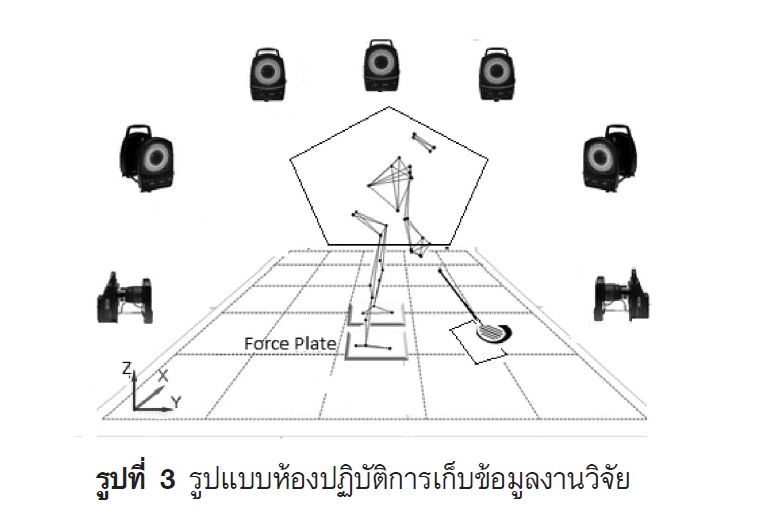THE RELATIONSHIP AMONG ANGULAR DISTANCE, ANGULAR VELOCITIES OF PELVIC ROTATIONS, CLUB HEAD SPEED, AND HITTING DISTANCE IN UNIVERSITY GOLFERS
Main Article Content
Abstract
Purpose : To study the relationships among angular distance, angular velocities of pelvic rotations, club head speed, and hitting distance in university golfers.
Methods : Nineteen amateur university male golfers participated in the study. The participants were asked to hit 3 balls with his maximum effort with a minute rest between trials. Thirty-five markers were placed over the body of the participants. The hit with the longest distance of each participants was selected to be analyzed using Vicon and bodybuilder program. Pelvic angular distance and angular velocity were calculated using vector manipulation and the hitting distance and club velocity analyzed using P3 Pro Swing Golf Simulator.
Results : The relationship between angular distance of pelvic and angular velocity or pelvic rotation was at high level (r=0.95, p<0.01). The relationship between club speed and hitting distance was at high level (r=0.99, p<0.01). The relationship between angular distance of pelvic and club speed and the relationship between pelvic rotation and hitting distance were both at a moderate level (r=0.54, p<0.05; r=0.51, p<0.05, respectively).
Conclusion : Pelvic rotation and angular distance of pelvic correlates with club speed and hitting distance. In order to increase club speed and, thus, hitting distance, golfers need to increase angular distance of pelvic as well as pelvic rotation.
Article Details
References
Beak, S. H., Choi, A., Choi, S. W., Oh, S. E., Mun, J. H., Yang, H., Song, H. R. (2013). Upper torso and pelvis linear velocity during the downswing of elite golfers.BioMedical Engineering OnLine, 12(1), 13.
Cole, M. H., & Grimshaw, P. N. (2016). The Biomechanics of the Modern Golf Swing: Implications for Lower Back Injuries. Sports Medicine, 46(3), 339-351.
Gordon, B. S., Moir, G. L., Davis, S. E., Witmer, C. A., & Cummings, D. M. (2009). An investigation into the relationship of flexibility, power, and strength to club head speed in male golfers. The Journal of Strength and Conditioning Research, 23(5), 1606-1610.
Horan, S. A., Evans, K., Morris, N. R., & Kavanagh, J. J. (2010). Thorax and pelvis kinematics during the downswing of male and female skilled golfers. Journal of Biomechanics, 43(8), 1456-1462.
Kwon, Han, K. H., Como, C., Lee, S., & Singhal, K. (2013). Validity of the X-factor computation methods and relationship between the X-factor parameters and clubhead velocity in skilled golfers. Sports Biomechanics, 12(3), 231-246.
Mun, F., Suh, S. W., Park, H. J., & Choi, A. (2015). Kinematic relationship between rotation of lumbar spine and hip joints during golf swing in professional golfers. BioMedical Engineering Online, 14, 41.
Rakthof, F. (2015). Nieuw bij Fysio Rakthof: Golf-Fysiotherapie. Retrieved from https:// fysio rakthof.nl/2015/03/31/nieuw-bij-fysiorakthof- golf-fysiotherapie/
Sim, T., Choi, A., Lee, S., & Mun, J. H. (2016). How to quantify the transition phase during golf swing performance: Torsional load affects low back complaints during the transition phase. Journal of Sports Science, 1-9.
Sinclair, J., Currigan, G., Fewtrell, D., & Taylor, P. (2014). Biomechanical correlates of club-head velocity during the golf swing. International Journal of Performance Analysis in Sport. (Vol. 14), 54-63.
Sommer, M., & Rönnqvist, L. (2009). Improved Motor-Timing: Effects of Synchronized Metro-Nome Training on Golf Shot Accuracy. Journal of Sports Science & Medicine, 8(4), 648-656.
Walker, B. (2007). The Stretching Handbook: Walkerbout Health; 3rd edition
Zheng, N., Barrentine, S. W., Fleisig, G. S., & Andrews, J. R. (2008). Kinematic analysis of swing in pro and amateur golfers.International Journal of Sports Medicine, 29(6), 487-493.


